Conflict Between East Zone and Southwest/West Zone Forces
Today, August 17, 2016, a Civil Party – who remained anonymous due to ongoing investigations in Case 004 – told the Court about conflicts between Southwest/West forces and East Zone soldiers. He then recounted how the Khmer Rouge arrested and attempted to kill him several times and how he escaped from this. Lastly, he talked about forced marriages in his district.
Civil Party: 2-TCW-1040
All parties were present with the exception of National Lead Co-Lawyer Pich Ang and with Nuon Chea following the hearing from the holding cell. Trial Chamber President Nil Nonn was absent and replaced by Judge Ya Sokhan. Civil Party 2-TCCP-1040 was heard today under his pseudonym[1] and Civil Party 2-TCCP-1029 was on the reserve. 2-TCCP-1040 confirmed his identity.[2]
Civil Party Lawyer Hong Kim Suon from Cambodian Defenders Project started putting questions to the Civil Party. The Civil Party was a soldier in Koh Keo Commune, Lvea Em District in Kandal Province. His unit was still at Koh Keo when the area was liberated. They were then asked to work in the fields. He was attached to unit 148 that belonged to the East Zone. It was said that Sao Phim was the Zone Secretary at the time. After the liberation in 1975, his unit was stationed in Koh Keo. He was transferred to Prey Veng Province later, where he built canals, dyke systems and roads. He was then moved to the west part of the Prey Veng Province to water the rice fields. He said that three cans of rice were given to 100 workers. This was a military unit.
Mr. Kim Suon referred to his previous interview, in which he had said that Sao Phim arranged for him to be positioned along National Road 5 and had referred to Khmer Rouge soldiers from the Southwest and West Zone.[3] He replied that his unit was called the National Liberation Army. After Sao Phim became aware that the Southwest soldiers surrounded the soldiers in the East Zone and that soldiers were transported from the Southwest to Svay Rieng as well as that people were arrested, Sao Phim gathered the forces in Office 200 in the East Zone to “join hands” in the movement. Sao Phim said that the Southwest forces came to kill all soldiers in the East Zone. The Civil Party had met Sao Phim once. “He came to architect the movement in the area”. During the regime, “there was no such thing as a volunteer. We had to undertake the assignment that was forced upon us. We were soldiers on the ground and we followed orders”. Mr. Kim Suon then asked how long it took them to mobilize the people. After the forces of the West and Southwest surrounded them for one week and “after we were agitated through the leaflets from the air, we were encouraged to be engaged in the activities with them”. They did not join them and remained at their respective locations. This was on National Road 15. They gathered around the provincial town of Prey Veng. Airplanes dropped leaflets, there were tanks and infantry. Heavy weapons and fires were shot.
Escaping the Battlefield
When he had fled from the battlefield, he picked a leaflet, which “encouraged all people and forces as well as civil servants in the East Zone to surrender with the West and Southwest forces”. The leaflet said that they did not “betray the nation” and that only the leaders betrayed the country, such as Sao Phim and his wife. It was said that Sao Phim encouraged a rebellion in the East Zone and encouraged forces to fight against the Southwest soldiers. Some soldiers had fled from Prey Veng Province. He witnessed people dying at the battlefield. “People died from time to time”. Men and children had to flee. “All of them died, because at the time, there was heavy firing and shelling all across the provincial town”. During the time of advancement of the Southwest and West forces, but when there was no heavy shelling, they all attempted to escape. “That is how I survived”.
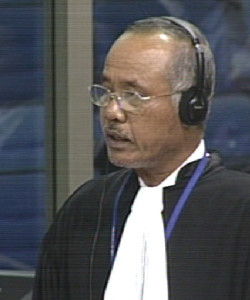
Civil Party Lawyer Hong Kim Suon
Mr. Kim Suon read an excerpt of the Civil Party’s interview, in which he had said that some of the people who escaped were arrested, some of whom were sent to Kampong Chhnang Airfield, and others being shot dead.[4] He recounted that soldiers from various units, including garment units, had fled. “We saw civilians die in the pond in the eastern part of Prey Veng”. After he had left the battlefield, he arrived at Ruos Veheak District, where they were arrested by the female militia and sent to Mesang District in Prey Veng Province and subsequently detained for one week. They were locked in a house at night and brought to work during the day. The chief of the prison made an announcement: “We were told that we were not traitors. They said that we were the children of the regime”. They were told that they could go back to their respective provinces and communes. “So I had left the prison”. He did not know other people there. There were around 30 people in total there.
Yeay Karo was the wife of Sao Phim, he said. The head of the unit told them that Sao Phim had shot himself in the head and that his wife also killed herself at O’Reang Ou. It was said that they were disemboweled and that grass was stuffed inside their bodies, “because they were traitors”. After they detained him, he was not shackled or handcuffed. He had one set of clothes. Mr. Kim Suon quoted the Civil Party’s interview, in which he had said that he and others were interrogated, after which those who had confessed having been traitors were tied to coconut trees, while he was released.[5]
Escaping Executions
After he left the prison, there were ten soldiers coming towards them around fifty meters later. These soldiers pointed their rifles at them. “There were around 30 of us at the time”. They were told to go into a temple and tied up there. They called out two of them at the time. They were blindfolded and their hands were tied behind their backs. They did not know where they went to, since they were blindfolded. Some of the people were hit with the rifle butts. After being told to go into the temple, he was hit. He did not know the location of the temple. They were asked to queue up in a line. “They used a lot of tricks in order for the forces to confess”. They said that if they did not confessed, their throats would be slit at the pond. If they confessed, they would be allowed to leave. “For me, I did not dare to confess, because I knew that the Khmer Rouge had many tricks in their heads, as the last result they would kill us.” He explained that they would be accused of being a traitor even when breaking a hoe. They were instructed to leave the temple later. “They tied us in a straight line to a rope and pulled us behind a vehicle”. This took place in the afternoon. “We were instructed to run after their bicycles, but were too slow. “Then we were beaten with a club”. He could not catch up either, “so they did beat me with a club on my head and it cracked. It was bleeding”. He was tired, because he had not had food the whole day.
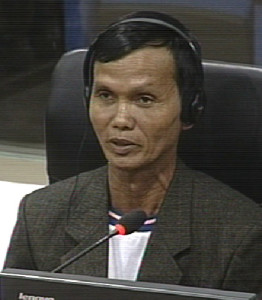
Civil Party (anonymous)
He arrived at a location by dawn. At this time, the wives of the Southwest and West soldiers untied them. The people who confessed were tied to a coconut tree. He heard the sound of beating and gunfire. “I presumed that they were shot dead”. He left the area, since they were allowed to return to their respective provinces. By the time he arrived in Svay Rieng, his family had been evacuated already. He was arrested and imprisoned in Svay Rieng. “However, while I was on the way to that prison, we were intercepted and fire broke out between the Vietnamese and Khmer Rouge troops.” It was said that out of 100 detainees at the prison, only one could survive. After the fighting with the Vietnamese, they were gathered and sent to Svay Rieng Provincial Town. When he crossed from Svay Rieng to Prey Veng Province, he was assigned to be in a mobile unit. He was subject to constant surveillance by the security forces. “I had no idea about my name being indicated in my biography, however somehow a marriage was organized”. He was married together with 60 couples. The ceremony lasted one day. “They announced that my would-be partner was called Kung Sopha”. However, he did not know who she was. By the time that they were called to present themselves in the kitchen hall near a pagoda. Asked about whether he fell in love with her, he said that “how could I have such a feeling at the time? I was so exhausting. I was forced to work”. It was “their plan” that he had to get married, despite the fact that he did not have any feeling. “Of course I was the target to be imprisoned, for that reason I did not dare to protest”.
After he got married, they were sent to Neak Leung in Prey Veng Province. He was put on a train heading to Pursat Province. When they got off the train, they were “tasked to overwork”. They searched them to ensure that they did not have any metals or knives with them. They were gathered again a few days later. “We were treated like animals. We were herded like animals”. They had pork and cow meat there and they were told that there was a ceremony. “There were many people herded in that enclosure”. They saw loudspeakers. The cow pen itself was built by children. “They dug pits”. There was only one entry and exit points. They saw the group equipped with clubs and knives and were instructed to sit in rows and to bend their hands. “And then they started to tie us one by one.” Some of them tried to remove the ties and some tried to resist to flee from the enclosure. “However, outside there was another group. They were on horsebacks”. Another group surrounded the enclosure on the ground. He himself fled, but did not encounter the soldiers on the horsebacks. He fled to the forest. “The rest were not that lucky”. Others were shot or clubbed to death. “We could see that killings were taking place everywhere, and we from the East Zone were subject to killing.” He ran to Pursat Province with others who escaped. They moved during night time. During the ten-day and ten-night trip, he encountered Khmer Rouge troops. He was recaptured and arrested to the east of Pursat Province, where he was deprived of food and water. “I almost died at that stage, that is due to the lack of food and the sun”. When they were taken away again, they were “in the middle of nowhere” 500 meters away from their location. They were instructed to sit down, facing them, “and of course they were about to […] shoot to us. Then I realized that we were about to be killed, but I did not know what happened. Maybe they were afraid that if they shot at us, the blood might splash at them”. They ordered them to face their backs towards them and run. After 15 meters he fell. Five meters later he was shot in the arms and some bones broke.
During the regime, his family members and his mother were separated into groups of those who could work. His family members all died. My cousins and other distant relatives also died. There were around 50 members of his family who all died. “And of course every time I think of them, I think of the suffering”. “I felt so lonely and painful, because I lost everyone on my side. Sometimes I have insomnia because of that. Sometimes my mind is not with me, I seem to get lost. And that is the result of the mistreatment that I received under the regime.” He was disappointed, because he had joined the resistance, but was tortured and shot at instead.
At this point, the President adjourned the hearing for a break.
East Zone Forces
After the break, it was announced that the Civil Party Lawyers could conclude their questioning after the Nuon Chea Defense Team had finished their questioning.
Mr. Koppe then started his line of questioning. He wanted to know whether he understood the Civil Party correctly that he was involved in the battle of the liberation of Phnom Penh, which the Civil Party confirmed. The Civil Party then proceeded to describe the battles along the Mekong River. He could not remember all the names of the commanders of his unit. The head of a company-K was called Mat. The chief of the battalion was called Chhon. He listed several battlefields that he was engaged him, where he was stationed to cut off supplies of Lon Nol forces. He had no specific tasks within this unit. They were not posted in Phnom Penh directly and had to fire at convoys or ships along the river. Later, his unit was stationed on Koh Keo Island and disarmed. After the liberation, his battalion was called number 148 from the East Zone. Back then, the forces of Heng Samrin were active. His force was tasked to reinforce Heng Samrin’s division. His unit was not under the command of Heng Samrin at Chruoy Chres. This was located close to the Mekong River. The Southwest forces criticized the East forces. The East Forces wore khaki forces, while the Southwest forces wore black forces. After the liberation of 1975, his unit was stationed at Koh Kraol, where he heard gunfire. “It was so intensified and could be heard all across my location.” He did not know whether complete victory had been achieved by then. “After the fall of Phnom Penh, I could hear the Saravan melody”. He heard later that Phnom Penh had been completely liberated. He did not know any other commanders than Heng Samrin. “I was a low ranking combatant. I only knew my direct superior, that is the commander of my battalion. That is the highest level that I knew.”
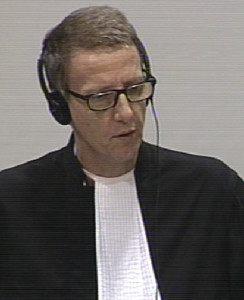
Nuon Chea Defense Counsel Victor Koppe
Mr. Koppe inquired whether he knew Heng Samrin’s older brother Heng Samkai. The Civil Party replied that he did not know his name at the time. Mr. Koppe referred to the Civil Party’s statement that he joined the army of Sao Phim “in order to fight the Khmer Rouge” and wanted to know whether he himself was not part of the Khmer Rouge forces.[6] He replied that he was a member of the liberation army and that he did not know at the time whether they were known as the Khmer Rouge forces at the time. He said that his forces belonged to the East Zone forces. When Sao Phim “agitated the movement”, he directed this against the Southwest and West forces, who surrounded them to kill the East Zone forces.
Mr. Koppe read another excerpt: he had said that the movement was “organized quickly and spontaneously” when surrounded by the forces.[7] Ms. Guiraud said that the French translation did not mention the word “spontaneously”. The Civil Party explained that “the agitation” took place quickly, and that Sao Phim had said that the Southwest and West soldiers came to kill the East soldiers.
The Southwest and West soldiers attacked the Provincial Town of the East Zone, after which Sao Phim shot himself to death, the Civil Party said. He heard him to ask them to rise up and resist on the radio, but were overwhelmed by the forces. After this, they surrendered. To his recollection, this took place around a week after he heard Sao Phim’s voice on the radio. He did not know the exact date. He did not know Pol Pot at the time. “I was a simple combatant and I did not know about such affairs”. They said that the East Zone forces colluded with the yuon side. “I did not know whether that was their pretext in order to get rid of [us]. They arrested and killed the commanders of the East Zone forces”. They made an appeal to the forces and people living in the East Zone to surrender. After the liberation in 1979, he received news that Vietnamese forces “joined hands with Khmer forces to liberate the country from the Khmer Rouge”. He did not know about the plan by the Vietnamese to overthrow the Khmer Rouge.
His knowledge was limited, he said, and he did not know about Sao Phim’s reactions to the accusations of treason. Mr. Koppe said that he had said that around 8,000 people joined the movement that fought the Khmer Rouge and wanted to know where he got that number from.[8] The Civil Party answered that it was his own estimate, “because many many people participated in the movement”. At the spearhead where his unit was based, people from all kinds of sections participated, “including those patients, including the people in the hospital, and other sections”. He did not know about the presence of civilians in other spearheads, he said.
At this point, the President adjourned the hearing for the lunch break.
Possibility of Plans to Overthrow Democratic Kampuchea Government
After the break, the floor was given back to the Nuon Chea Defense Team. Mr. Koppe asked to clarify the timeline of events: his Civil Party Application seemed to indicate that the resistance seemed to form between 1976 and 1978, which was before the events he had described.[9] He replied that he did not know about it before. Mr. Koppe sought clarification about the term “tempering troops” that was mentioned in his Written Record of Interview.[10] He answered that “soldiers were being tempered” between 1976 and 1978. They were given only three cans of rice. The meal was very watery, so they mixed it with tree leaves. Some died when mines in the ground exploded when they were digging canals. The Easter Zone soldiers were assigned to dig canals.
Mr. Koppe said that it was the position of the Prosecution that the Vietnamese government had made plans to overthrow the Democratic Kampuchea government from February 1978. He further sad that some scholars already started in September or October. Mr. Koppe inquired whether he had heard of any plans by this. He pointed to a book by Nayan Chanda who had said that Heng Samkai made plans to overthrow the Democratic Kampuchea government.[11] He replied that he was not aware of this, because he was only a simple combatant. He did not possess any radio-communicator and was therefore not aware of all issues. Mr. Koppe read another except and asked whether he was aware of any secret food reserves in the jungle.[12] He answered that he was not aware of this. Mr. Koppe explained that he asked this, because it seemed like he was aware of where Sao Phim had retrieved their weapons from.[13] The Civil Party now said that he did not know where he received the weapons. They were stationed at the north side of Mey Buon. The food supply was distributed by the logistic unit.
Mr. Koppe asked what he meant when he told the investigators that “Sao Phim arranged for me to be positioned along National Road 15.”[14] He replied that he received the order from his commander. Usually this would go through the hierarchical order. Mr. Koppe referred to another document, to which the Civil Party reacted by saying that he was not aware of a statement made by Heng Samrin about collaborating with the Vietnamese.[15] The words “secret struggle” did not mean anything to him.
Back to Marriage
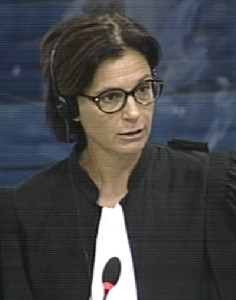
International Lead Co-Lawyer Marie Guiraud
The floor was granted back to the Civil Party lawyers. International Civil Party Lead Co-Lawyer Marie Guiraud turned back to the topic of marriage. She asked whether an explanation was given to him about why he had to get married. They did not provide any detailed explanation and simply announced that “Angkar required us to marry”. He recalled that there was a company chief and a female chief of the four female mobile units who participated in the marriage ceremony. At 3 pm, “there were only three lotuses on the table”. There were two lines of women and men. They called a person from each group. They looked into the biographies and if “they matched” they would call the people to get married. “If we were a soldier from the East Zone, and if the woman also had siblings or relatives who were soldiers, we were a match”. He spent the first night with his newly-wed wife. “But we both did not love one another. Although we were sleeping in the same house, we did not have feelings for each other at all”. They had a list of militiamen to monitor the couples. “If the newly-wed couples did not consummate the marriage, they would take measures”. He did not know what measures these would be. “As for me personally, I did not touch the first night, nor in the night after”. He continued: “Only days later I had a feeling for her. I had pity for her”. Later he learned through those who got married at the same ceremony that some of them were accused of being traitors and that they opposed the policies of Angkar. With this Ms. Guiraud concluded the Civil Party Lawyers’ questioning.
Mr. Koumjian asked for the Co-Prosecution whether he knew his wife before he married her. He denied this and recounted that he knew the name only one day in advance. “I tried to see who she was, because I only knew her name, and then I found her”. He did not know her age at the time. He only saw her briefly before the marriage. She looked younger than him from her appearance. They were under constant attack of the Vietnamese troops at the time.
They knew that he was a soldier from the East Zone. He said that they should have allowed them to allow each other’s feeling first before making them marry. “And that was far off the tradition we were used to”. The wedding took place in the kitchen hall.
Back to the East Zone
Sao Phim said that the Southwest and West soldiers surrounded the East Zone soldiers with the aim of killing them. “If we dared to rise up, then we had to unite as one”, Sao Phim had said, the Civil Party recounted. He “no longer had any feelings to engage in any war”, so he went along with the rest.
Mr. Koumjian referred to a statement by Meas Suon, who had said that there was an arrest of many people, and that he received a letter by Sao Phim to be “ready to fight to rescue”, because it seemed like there was a military coup directed by Son Sen.[16] He replied that he was stationed at Koh Keo Island at the time, after which he arrived at Prey Veng Province, where Sao Phim organized a meeting. During the meeting, Sao Phim spoke about the forces from the Southwest and West Zone.
Death of his relatives
Mr. Koumjian then asked where his mother and siblings died. He answered that his mother and siblings died in Svay Luong Cooperative at Tuol Talo. There was a dense forest. “And there were lions and wolves in those forests as well”. Thus, more than fifty of his relatives died. They were killed under the accusation that they were yuon enemies and that “people from the East had links to the yuon.”
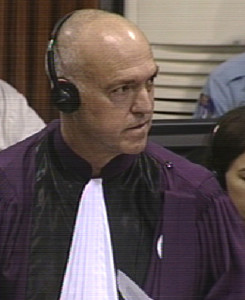
International Co-Prosecutor Nicholas Koumjian
They were given special shirts to the East Zone people and could therefore be distinguished very clearly. “People at Pursat really loved their blue scarves or kramas”, but they were told not to give them to them. He was sent to Bakan District once. Mr. Koumjian played a video and asked the Civil Party whether he recognized anyone.[17] This video showed an interview with a former Khmer Rouge cadre and talked about the killing of ethnic minorities, saying that the orders stemmed from the higher hierarchical level.
Mr. Koppe objected, saying that the video clip was about the alleged killing of Kampuchea Krom, which was outside the scope of the trial. Khieu Samphan Defense Counsel Anta Guissé also said that they had no prior knowledge about the use of this video. Mr. Koumjian replied that he intended to use it in relation to the killing of the East Zone people.
At this point, the President adjourned the hearing for a break.
Killing of Minorities
After the break, Judge Claudia Fenz said that the question whether he recognized anyone in that video clip was allowed. Mr. Koumjian then repeated his question to the Civil Party, who replied that it did not “seem clear to him”. However, Run and Khoun were in Bakan District. Rom was the chief of the district, while he had only heard of Khoun’s name. Run chaired meetings at the cooperative that took place every ten days. During such meetings, she raised a number of points: to promote the work on canals and roads as well as harvesting rice; and to eliminate traitors in the district. Mr. Koppe objected and said that this was now outside the scope of the trial. Mr. Koumjian replied that this was part of the Joint Criminal Enterprise and therewith part of the case. The objection was overruled. They heard that the people from the East Zone would be relocated. Two or three families would be relocated at the same time. Sometimes Angkar said that they were re-educated. “They never returned”. Run talked about eliminating all traitors from the district, but did not specify who these traitors were.
Arrest of Division Commanders
Mr. Koumjian turned back to arrest of division commanders and inquired who arrested these people. He replied that they were told that all division commanders and their messengers were called to a meeting and disappeared. Sao Phim concluded that they were all killed. People who lived in the zone or in Prey Veng Provincial Town were killed and fired upon during the attacks. When he fled, the situation was “chaotic”. He saw some people die. With this, Mr. Koumjian concluded his line of questioning and the floor was handed to the Khieu Samphan Defense Team.
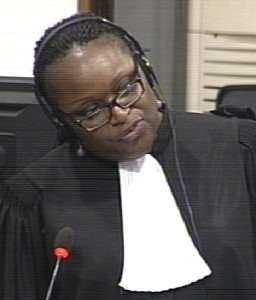
Khieu Samphan Defense Counsel Anta Guissé
Back to Marriage
Ms. Guissé asked how old he was when he got married. He replied that he must have been around 25 years old at the time. He estimated that his wife was around five years younger than him. He confirmed the name of his brother, which is not published here due to reasons of anonymity.. He said 50 percent of his family members were killed. Ms. Guissé showed a document to the Civil Party.[18] He said that his brother’s name was correct, but the mother’s name was different. He then confirmed the identity. Ms. Guissé asked about his family members.[19] He said that it did not include his relatives, nephews and uncles, but only concerned his siblings and parents. Asked to clarify a term in his application, he said that at least fifty relatives of his had been killed, including uncles, aunts, and nephews. This included the siblings of his wife as well. After his wedding, his wife was introduced to his family members. At this point, Ms. Guissé concluded her line of questioning. Mr. Koppe had one follow-up question.
Mr. Koppe said that his brother had listed Khmer Krom as his nationality.[20] The Civil Party said that he and his brother were “real Khmer” and not Khmer Krom. Mr. Koumjian clarified that the field on nationality indicated that his brother was Khmer.
Questions by the Civil Party
The Civil Party then put questions to the accused through the Trial Chamber President:
“In fact, I want the accused to answer frankly about the torture inflicted on me as well as the attempt to kill me. My hands were tied behind my back and I was asked to run behind the bicycle and I was dragged along the road, and I was also deprived of meal. Number two, I was taken into an enclosure, or a cow pen, in order to be killed, and I was treated as [an animal]. And point number three, after I was arrested, I was tied in order that they could take me to be killed, and as a result I was injured, and as a result I became a disabled person. One of my arms was injured. And the injury sustained until today. I have been going around to different hospitals to have the treatment of my inured arm, but it is in no vain. And because of my disabled arm, I am in a difficult situation to make a living. I would like the President to ask the accused who is responsible for my suffering, and in particular who is responsible for the disabled arm that I have sustained until today, because the veins have been removed from my arm. So who is responsible for my injury?”
The President informed the Civil Party that the two accused invoked their right to remain silent. He then adjourned the hearing, which will continue tomorrow, August 18, 2016, at 9 am.
[1] Following E319/35.
[2] E3/9467, at 00955747 (KH), 00978749-50 (EN), 01033002 (FR).
[3] E3/9467, at 00955748-09 (KH), 00978752-53 (EN), 01033004 (FR).
[4] E3/9467, at 00955750 (KH), 00978754 (EN), 01033006 (FR).
[5] D22/30a, at 00584803 (KH), 01194873-74 (EN).
[6] E3/9467, at answer 15.
[7] E3/9467, at answer 17.
[8] Ibid.
[9] E3/6859, Civil Party Application, 0131274 (KH), 00571255 (KH).
[10] E3/9467, at answers 9-15.
[11] E3/276, at 00192440 (EN), 00237111 (FR), 00191517 (KH).
[12] E3/276, at 00192381 (EN), 00237064 (FR), 00191529 (KH).
[13] E3/9467, at answer 19.
[14] E3/9467.
[15] E3/1568, at 00551889 (EN), 00713962 (FR), Khmer ending at 3361.
[16] E3/5531, Statement by Meas Suon, at answer 62.
[17] E3/1004R, at 43:20.
[18] E3/5954, at 00478090 (KH).
[19] At 00478490 (KH).
[20] E3/5954, at 00427076 (EN).
Featured Image: Civil Party 2-TCCP-1040 (ECCC: Flickr).
